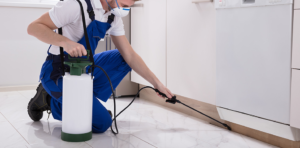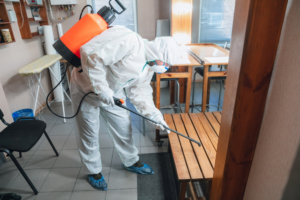Pest Control Malibu involves managing the existence of a pest to minimise risk to humans and their property. It includes prevention, suppression, eradication and monitoring.
Physical controls include traps, barriers and exclusion techniques. These methods are generally safer than chemical options, especially when children and pets are present.

Resistant cultivars, pheromones and juvenile hormones are also used. These methods usually do not eradicate the pest but can significantly reduce their numbers.
Prevention
Pests can cause a lot of problems, from gnawing on wires to carrying diseases such as hantavirus and leptospirosis. The best way to deal with them is through prevention.
A preventive program should involve inspecting the exterior and interior of a building, identifying entry points, and removing attractants such as scraps or trash. For food establishments, regular inspections of storage areas are also a good idea.
Many pests are able to reproduce only under certain environmental conditions; this means that their presence is likely to increase or at least become more frequent in a given environment unless steps are taken to eliminate those conditions. For instance, plant diseases that occur only under particular circumstances can be prevented by choosing disease-resistant varieties of plants.
Other preventive measures include reducing the availability of food, water and shelter for pests, sealing cracks, storing garbage in sealed containers, and fixing leaky plumbing. These measures reduce the reliance on and corresponding risk from chemical pesticides, which are generally only used when other options have been exhausted or the threshold level for an infestation has been reached. This approach is known as Integrated Pest Management (IPM).
In general, pests are most easily controlled when they are young and small; it is often difficult to kill them at mature or adult stages. That is why it is important to understand the life cycle of the pests in order to choose control methods that will be effective.
There are many different types of biological pest controls, ranging from predators to parasites and pathogens. Biological methods do not require the use of chemicals and therefore are often less toxic to humans and animals. However, they are usually only effective on small pest invasions and they may take some time to be effective.
Chemical barriers can be physical or chemical and may include a combination of both. Physical barriers are based on structural modifications, whereas chemical barriers rely on the application of pesticides to create protective zones. It is important to carefully select and apply these barriers, taking into account toxicity and the effect on beneficial insects.
Suppression
Pests can cause serious damage to crops, livestock, and property. They can also transmit diseases to people and their pets. Pest control involves identifying the pest, inspecting the problem area, and applying one or more controls. This is usually done by a professional pest control technician. However, some people choose to take the do-it-yourself approach to pest control. There are numerous books and Web sites that offer advice on home pest control, but the use of these methods requires careful consideration of the potential risks involved.
Integrated pest management (IPM) is a form of pest control that aims to minimize the use of toxic chemicals and encourages natural predators and parasites to keep pest populations low. IPM programs may include physical, biological, cultural, or chemical controls. Physical controls are usually less invasive than chemical treatments. They involve things like trapping or blocking pests, and can be as simple as placing sticky traps for ants.
Many pests thrive only as long as they have a food source and a place to hide from predators and overwinter. Natural features such as mountains and bodies of water restrict the spread of some pests, while habitat degradation can lead to localized population explosions.
A pest can be a weed, fungus, virus, bird, rodent, invertebrate such as mites or caterpillars, insect, tick or flea, and even bacteria. Often, pests disrupt human occupation of land by competing with people for food and shelter. They can also damage or degrade buildings, landscapes, and natural resources.
Pests are categorized as continuous, migratory, or sporadic and require regular pest control to prevent serious damage or public health risk. Some pests are more vigorous or tolerant than others, and can survive attacks by more aggressive species. Some plants, animals, and structures resist specific pests better than others, and use of resistant varieties, when available, can help reduce the need for regular control.
A pest’s identity, life cycle, and level of activity is essential for choosing the proper control method. Without this information, you could be applying control measures blindly, or wasting money and energy on ineffective controls. Before any treatment is started, a thorough inspection of the infestation site is done to identify entry points and nesting areas. A plan is then created to address the pest problem using targeted interior and exterior treatments.
Eradication
It’s tempting to reach for the can of insect spray in a panic when you see pests invading your home or business. But it’s important to stop and think. Many pests don’t actually pose any threat at all – they just look unpleasant. And even if they do, you might not need to call the exterminators at all. In fact, the Department of Health recommends trying to eradicate pests with safe, nonchemical methods first before resorting to chemicals.
The Integrated Pest Management (IPM) approach is one of the most effective ways to deal with unwanted pests and insects. The first step in an IPM plan is evaluating the problem to determine how much damage the pests are causing. This is called determining the threshold level of damage and it allows you to select an appropriate control strategy.
IPM strategies can include using natural enemies to reduce pest populations such as lacewings and lady beetles that target aphids. There are also a number of other tactics that can be used to suppress pests, including physical control and cultural control. Cultural controls can be as simple as changing irrigation practices or removing weeds that act as food for pests. Physical control involves sweeping up strays with flyswatters or placing mousetraps and jar traps in strategic locations.
Chemical pesticides have their place and are sometimes necessary, but the best way to use them is to follow strict application guidelines. This ensures that they are used safely and effectively and minimizes the chance of them affecting the environment or causing any health problems for family members, pets or employees.
It is also important to understand that pesticides work in stages. A pesticide applied at the wrong time will not work or could even have a negative effect. This is because the pest may be in a different stage of development or may have developed resistance to the chemical.
Another reason pesticides can fail is because they are overused. Insects that have been exposed to repeated spraying of over-the-counter pesticides can develop chemical resistance and can be a danger to your health. It’s therefore important to read the label of any chemical you purchase to ensure that it contains detailed instructions on how and where to use it correctly and safely.
Monitoring
Pests can cause significant damage to the integrity of facilities and products. Regular monitoring can help prevent a problem before it occurs. Pests can also carry disease-causing pathogens and allergens that pose a health risk to employees and customers. Routine inspections and treatments can keep pest populations below the action threshold, thereby reducing the need for chemical controls.
Threshold-based decision-making is a key aspect of a well-developed proactive IPM program. Using information collected from scouting and monitoring, a facility can determine when to take action by comparing observed pest populations to pre-determined thresholds (action levels). For example, observing one or two wasps in an area may not warrant immediate control. However, seeing a large number of wasps in the same location, day after day, should prompt an investigation and possible removal of their nest.
Insect monitoring is typically done with glue boards and sticky traps. In addition, insect pheromones can be useful in determining if pest numbers have increased or decreased. Monitoring can also be done by examining harborage areas, such as cracks and crevices, for signs of infestation. A flashlight, a magnifier, and an extendable mirror can be helpful in locating these hiding places.
Rodent monitoring is typically done with bait stations containing rat or mouse traps. Observing the amount of bait consumed provides insight into the level of pest activity. For instance, if rodent bait is consistently being taken out of a station, it may be time to increase the frequency at which it is refilled.
Other pests, such as weeds and fungus, are monitored with a variety of methods including inspection and collecting samples for testing. Data collected from scouting and monitoring can provide information to determine an appropriate herbicide or fungicide to use.
Eliminating entry points into a facility and modifying operational practices can be a great way to prevent pest problems from arising. Doors, windows and fan vents should be tightly closed. Gaps in ceilings and walls should be filled with metal strips or chicken wire. Vents should be covered with screened covers. Hoist apertures should be covered with tarps when not in use.

